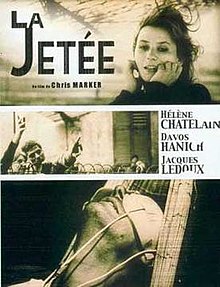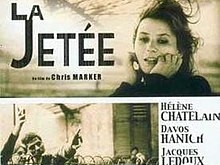La Jetée ***** (1962, Hélène Chatelain, Davos Hanich, Jacques Ledoux, voice of Jean Négroni) – Classic Movie Review 9527
Writer-director Chris Marker’s brilliantly teasing and challenging 1962 28-minute French black and white science fiction featurette La Jetée (The Jetty) is constructed almost entirely from still photographs and tells the story of a man and a woman and a post-nuclear war experiment in time travel.
Scientists researching time travel in post-apocalyptic Paris settle on a prisoner (Davos Hanich) whose key to the past is a vague obsessive memory from his pre-war childhood of a woman (Hélène Chatelain) he had seen on the observation platform (the jetty) at Orly Airport before witnessing a man die there. He reaches the pre-war period and meets the woman from his memory, and they develop a romantic relationship.
Mesmeric and fascinating, La Jetée is a unique experience, intense, eerie, unsettling, and frankly doomy, and open to endless interpretation and re-interpretation. Clearly, Alfred Hitchcock’s 1958 Vertigo is an influence on Marker, and on the score, and, like Vertigo, La Jetée is beguiling but ultimately elusive, hence, in part, their enduing fascination.
The film plays out as a photo-montage of varying rhythms, with minimal sound in the form of narration (by Jean Négroni), orchestral score (by Trevor Duncan) and sound effects. It contains only one brief motion-picture shot of the woman sleeping and waking up.
It won the Prix Jean Vigo for short film in 1963. How to describe it? A short film, a featurette, a film? Marker called it a photo novel (‘un photo-roman’).
Terry Gilliam’s 1995 film 12 Monkeys was inspired by La Jetée and borrows concepts from it. Gilliam was entranced by it, describing its combination of editing and soundtrack as ‘simply poetic’.
Also with Jacques Ledoux as The Experimenter, Ligia Branice as a woman from the future, Janine Kleina as a woman from the future, and William Klein as a man from the future.
© Derek Winnert 2020 Classic Movie Review 9527
Check out more reviews on http://derekwinnert.com



